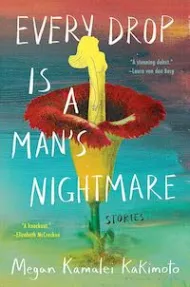
Author Megan Kamalei Kakimoto burst onto the literary scene with 2023's Every Drop is a Man's Nightmare, a short story collection infused with the rich cultural influences of her native Hawaiʻi. The book went on to become a USA Today national bestseller that was named an Indies Introduce title and a September Indie Next pick by the American Booksellers Association.
Callie Garnett, an editorial director at Bloomsbury Publishing, helped to shepherd the book to its public debut by serving as its editor.
On March 21 and 22, Kakimoto and Garnett will visit Washington University as part of the Center for the Literary Arts Speaker Series to discuss how the book evolved and crossed the finish line of publication, including their work as a writer-editor team.
Ahead of that visit, we asked the duo to shed a bit of light on how writers and editors collaborate, as well as their perspectives on the modern publishing industry.
During your talk on March 21, you'll dive into the editing process for Every Drop is a Man's Nightmare. What are some common misconceptions about how editing works – from early-career writers or members of the public? We tend to romanticize writing as a solo endeavor, but editing is really where a book takes its shape.
Garnett: Sometimes editing is where a book takes shape. Sometimes editing is where a fully shaped book gets tuned up. It really depends. The most common misconception I encounter about editing is that it’s the only thing editors do. In reality, a lot of our work is sales, project management, less glamorous things. We edit after hours.
Kakimoto: While the act of writing might seem solitary to many, I rarely regard it as such. To me, so much of writing is about engaging in conversation—with my ancestors and inherited stories, with writers whose work have influenced my own, with imagined readers, with the readers I seek to reach. Likewise, I believe the writer-editor relationship to be one of significant consequence, and echo the space of editing and revision to be where a book takes its final form.
When I first set out to work on this book with Callie Garnett and Bloomsbury, I had little to no idea of what to expect. I felt totally removed from the world of publishing, and honestly still couldn’t believe someone wanted to spend meaningful time with my work. My understanding of editing was essentially equivalent to copy editing—fixing my unpolished grammar and tempering my emphatic use of the em dash. I understand now how the work of copy editing, while incredibly important to a book’s publication, does not adequately represent the deep work performed by editor and writer.
My time with Callie showed me how a thoughtful editor can draw out the fiery heart of a story, seeing the potential in lines I’d overlooked, and the waste in language the story had outgrown. It also made clear to me the absolute gift I had received in an editor who is also a poet.
What are some of the elements of an excellent writer-editor relationship?
Kakimoto: I find the elements of an excellent writer-editor relationship to mirror the elements of any meaningful relationship in one’s life—whether that be familial, romantic, or platonic. It demands clear communication, thoughtful intentionality, honesty, and mutual respect. I’d also add, perhaps unique to the writer-editor relationship, is a shared desire to care for the creative work with the rigor and respect it deserves.
Garnett: For me? Chemistry happens when both bring humility, curiosity, and maybe a spark of mischief, a sense of wanting to start a fire together.
For students or early-career professionals, what should they know about entering the publishing industry in 2024? We tend to hear a lot of doom and gloom about the state of traditional media in recent years, but what bright spots do you see in the field?
Garnett: I see a healthy restlessness. It’s no longer a given that you have to live in New York City to work at the publishing houses with major distribution. That’s great. And new models are cropping up. Digital self-publishing is more viable than ever. Places like Authors Equity are moving away from the traditional advance (and high overhead) model. The industry is having to reckon with AI immediately…yesterday. Will this all work out to the benefit of authors and readers? I don’t know! But people are jumpy, and sometimes when they’re jumpy, they get creative.
Kakimoto: Though I feel admittedly incapable of describing the current publishing landscape, I can at least share how many books in recent times, even in the last year, have moved me, challenged me, changed me. I’m thinking of titles as diverse as The Night Parade by Jami Nakamura Lin, Blackouts by Justin Torres, Dream of Xibalba by Stephanie Adams-Santos, and Hangman by Maya Binyam. Books that have made and unmade me.
Always, I think there is critical work to be done to champion marginalized voices. My own heart is in uplifting and amplifying Kānaka Maoli and Pasifika authors, for there are so many of us, and not nearly enough are being celebrated in the world today. But I take immense comfort in every opportunity I have to celebrate diverse and Indigenous stories and storytellers, and look forward to encountering more books that make and unmake me.



